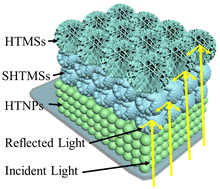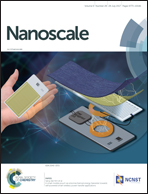Rational design of a tripartite-layered TiO2 photoelectrode: a candidate for enhanced power conversion efficiency in dye sensitized solar cells†
Abstract
A tri-layered photoelectrode for dye-sensitized solar cells (DSSCs) is assembled using single crystal hollow TiO2 nanoparticles (HTNPs), sub-micro hollow TiO2 mesospheres (SHTMSs) and hierarchical TiO2 microspheres (HTMSs). The bottom layer composed of single crystal hollow TiO2 nanoparticles serves to absorb dye molecules, harvest light due to its hollow structure and keep a better mechanical contact with FTO conducting glass; the middle layer consisting of sub-micro hollow mesospheres works as a multifunctional layer due to its high dye adsorption ability, strong light trapping and scattering ability and slow recombination rates; and the top layer consisting of hierarchical microspheres enhances light scattering. The DSSCs made of photoanodes with a tripartite-layer structure (Film 4) show a superior photoconversion efficiency (PCE) of 9.24%, which is 7.4% higher than a single layered photoanode composed of HTNPs (Film 1: 8.90%), 4.6% higher than a double layer-based electrode consisting of HTNPs and SHTMSs (Film 2: 9.03%) and 2.6% higher than a double layer-based electrode made of HTNPs and HTMSs (Film 3: 9.11%). The significant improvements in the PCE for tri-layered TiO2 photoanodes are mainly because of the combined effects of their higher light scattering ability, long electron lifetime, fast electron transport rate, efficient charge collection and a considerable surface area with high dye-loading capability. This study confirms that the facile tri-layered photoanode is an interesting structure for high-efficiency DSSCs.



 Please wait while we load your content...
Please wait while we load your content...